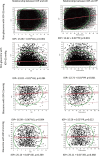The arterial stiffness and pulse pressure are predictors of intraocular pressure in a middle-aged population
- PMID: 40595877
- PMCID: PMC12215445
- DOI: 10.1038/s41598-025-05639-0
The arterial stiffness and pulse pressure are predictors of intraocular pressure in a middle-aged population
Abstract
The vascular theory posits that glaucoma is associated to ocular blood flow alterations. However, there is uncertainty regarding the association of arterial stiffness index (ASI) and pulse pressure (PP) to intraocular pressure (IOP). This study investigates the relationship between ASI and PP, and IOP, using the UK Biobank population. Among 89,930 participants of the UK Biobank population, ASI and PP were assessed, and their correlations with IOP were estimated using multiple linear and logistic regressions adjusted for age, sex, BMI, diabetes, dyslipidemia, mean blood pressure, heart rate, tobacco smoking status, previous CV diseases and antihypertensive therapy. Youden indices were determined for ASI at a value of 9.41 m/s and for PP at 49.18 mmHg to determine IOP > 21mmHg. After adjustment for all covariates, ASI > 9.41 m/s was significantly correlated with IOP levels, B = 0.054 [0.031; 0.076] and with IOP > 21 mmHg, OR = 1.057 [1.004-1.113]. PP > 49.18 mmHg was significantly associated with IOP levels, B = 0.378 [0.345; 0.401] and with IOP > 21 mmHg, OR = 1.558 [1.474-1.648]. Similar results were observed when considering ASI and PP at continuous levels. When considering participants with IOP < 21 mmHg (N = 83,079), ASI > 9.41 m/s and PP > 49.18 mmHg were significantly associated with IOP levels, B = 0.015 [0.008; 0.021], B = 0.286 [0.266; 0.306], respectively. We demonstrated that increased ASI and PP levels are associated with increased IOP. These findings provide new insight into the vascular theory between IOP and ASI.
Keywords: Arterial stiffness; Arterial stiffness index; Atherosclerotic pulse pressure; Glaucoma; Intraocular pressure.
© 2025. The Author(s).
Conflict of interest statement
Declarations. Competing interests: The authors declare no competing interests. Ethics of approval statement: The study was conducted according to the guidelines of the Declaration of Helsinki and approved by the Northwest – Haydock Research Ethics Committee (protocol code: 21/NW/0157, date of approval: 21 June 2021). Patient consent statement: Written informed consent has been obtained from the patients.
Figures
Similar articles
-
Perioperative medications for preventing temporarily increased intraocular pressure after laser trabeculoplasty.Cochrane Database Syst Rev. 2017 Feb 23;2(2):CD010746. doi: 10.1002/14651858.CD010746.pub2. Cochrane Database Syst Rev. 2017. PMID: 28231380 Free PMC article.
-
Fornix-based versus limbal-based conjunctival trabeculectomy flaps for glaucoma.Cochrane Database Syst Rev. 2021 Aug 26;8(8):CD009380. doi: 10.1002/14651858.CD009380.pub3. Cochrane Database Syst Rev. 2021. PMID: 34437715 Free PMC article.
-
Rho kinase inhibitor for primary open-angle glaucoma and ocular hypertension.Cochrane Database Syst Rev. 2022 Jun 10;6(6):CD013817. doi: 10.1002/14651858.CD013817.pub2. Cochrane Database Syst Rev. 2022. PMID: 35686679 Free PMC article.
-
Anti-vascular endothelial growth factor for neovascular glaucoma.Cochrane Database Syst Rev. 2023 Apr 3;4(4):CD007920. doi: 10.1002/14651858.CD007920.pub4. Cochrane Database Syst Rev. 2023. PMID: 37010901 Free PMC article.
-
Aqueous shunts for glaucoma.Cochrane Database Syst Rev. 2017 Jul 28;7(7):CD004918. doi: 10.1002/14651858.CD004918.pub3. Cochrane Database Syst Rev. 2017. PMID: 28750481 Free PMC article.
References
-
- GBD 2019 Blindness and Vision Impairment Collaborators & Vision Loss Expert Group of the Global Burden of Disease Study. Causes of blindness and vision impairment in 2020 and trends over 30 years, and prevalence of avoidable blindness in relation to VISION 2020: the right to sight: an analysis for the global burden of disease study. Lancet Glob Health. 9, e144–e160 (2021). - PMC - PubMed
-
- Lotery, A. J. Glutamate excitotoxicity in glaucoma: truth or fiction? Eye Lond. Engl.19, 369–370 (2005). - PubMed
-
- Chrysostomou, V., Rezania, F., Trounce, I. A. & Crowston, J. G. Oxidative stress and mitochondrial dysfunction in glaucoma. Curr. Opin. Pharmacol.13, 12–15 (2013). - PubMed
MeSH terms
LinkOut - more resources
Full Text Sources
Medical
Miscellaneous




